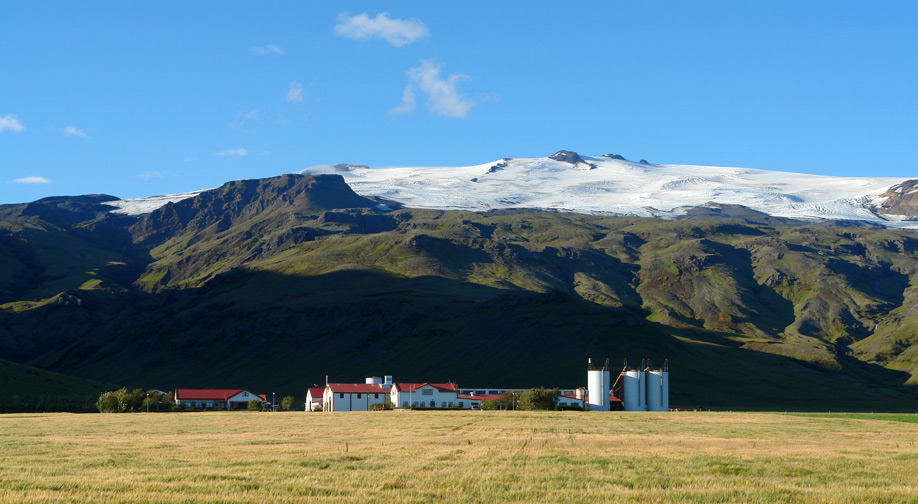I’d always wanted to live under a glacier so I was lucky when I met my husband Ólafur whose family had farmed here for three generations.
At the beginning of a short documentary on Þorvaldseyri, the farm directly below the Eyjafjalljökull volcano, which famously erupted in 2010, shutting down all air traffic in northern Europe for a about a week, Guðný A. Valberg, explains why she came to live and raise a family in such a potentially life-threatening place.
Throughout the 20-minute film, shown regularly at the Þorvaldseyri Visitor Centre in southern Iceland, Guðný discusses the eruption and her family’s response to it in a phlegmatic, no-nonsense manner, singularly lacking in the hysteria that engulfed the rest of the world at the time. Indeed, she expresses surprise and amusement at all fuss in other parts of the world caused by their “little volcano.”

The farm at Þorvaldseyri. Copyright http://www.thorvaldseyri.is
Ólafur and Guðný were of course very well prepared for the eruption and ready to evacuate at a moment’s notice if necessary. There had been a marked increase in seismic activity in the region at the end of 2009, which continued into 2010, and on March 20, a small fissure opened on the north side of the nearby Fimmvörðuháls ridge. The Fimmvörðuháls eruption lasted around 23 days and became an instant tourist attraction with visitors hiking up the mountain to watch the pyrotechnics at close quarters. About 24 hours after the Fimmvörðuháls eruption ceased, another series of earthquakes began at midnight on 13 April, this time directly under the summit crater of Eyjafjalljökull. The eruption was small at first but strengthened rapidly, blasting tons of fine ash into the air and causing a glacial flood which inundated the farmland below. For about four days, the farm was covered in a cloud of ash and the family was forced to evacuate after making sure their horses and cattle were safe.
The damage to the farm and surrounding coastal area was severe and at one point Ólafur wondered if the farm that had been in his family for more than 100 years would survive. But the family went about repairing the damage in a logical, matter of fact, way, initially getting the geothermal power plant up and running again so that the buildings were resupplied with hot water and electricity, and then clearing away the ash, sometimes with the assistance of foreign tourists who collected it as souvenirs.
Watching Ólafur, who must have been 60-years-old at the time, clearing his land and effortlessly hurling rocks and boulders out of the flooded river bed, it reminded me of the heroic deeds of the Icelandic Sagas in which stout and hardy settlers like Skallagrím exhibited feats of tremendous strength on an almost daily basis. You have to be tough to live in rural Iceland. The severe climate, the isolation, the constant danger of rock falls, avalanches, floods and volcanic eruptions necessitates a resilient and stoic mindset in which you prepare for and accept the danger but make the most of what this remarkably beautiful land has to offer.
Ólafur, following in his grandfather and father’s footsteps, has developed a modern, efficient farm with more than a 100 head of beef and milking cattle and 100 hectares of cultivated land producing wheat, barley and rape, while Guðný has an award-winning market garden that was newly replenished after the 2010 ash fall. The documentary shows Ólafur and Guðný at work on their farm with their four children and grandchildren, scenes which again could have been taken straight from the Sagas in which the early settlers and their children established a presence and connection to the land that in some places is still evident today. In the northern valley of Vatnsdæla, for example, the direct descendant of Ingimund the Old, who first settled the region more than a thousand years ago, is living at the site of the original homestead of Hof. He is surrounded by the stories of his ancestors which are now ingrained into the very fabric of the land. All the place names have a story to tell such as Þórdísarholt, the wood at the head of the valley where Ingimund’s daughter Þórdís was born. For Ingimund’s descendants, this all very natural and unremarkable; as the current occupant of Hof said simply: “I am part of the landscape now.”
His remarks echo those of Gunnar Hámundarson in one of the most famous scenes from all the sagas, which takes place in the hills just a 30-minute drive from Þorvaldseyr. Gunnar has been sentenced to three years exile abroad but just as he is about to leave, he turns to take one last look at his land beneath the glacier and declares: “the slope is beautiful, I will not leave.” Gunnar’s action is not the result of a sentimental attachment to the land rather it is a deep, visceral connection that makes Icelanders an integral part of the landscape rather than mere observers of it. Gunnar knows that refusal to leave will put his life in danger but the thought of exile was much worse.
Back at Þorvaldseyri, Ólafur and Guðný and their family continue their lives and their work on the farm as normal, largely ignoring the tourists posing for selfies outside their front gate. As Guðný remarks towards the end of the documentary: “Let’s hope the volcano has got it out of its system and we can live in harmony together again.”
2 thoughts on “I always wanted to live under a glacier”
Comments are closed.